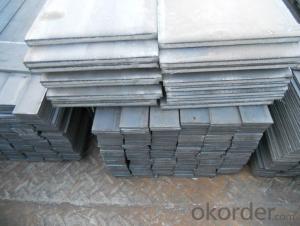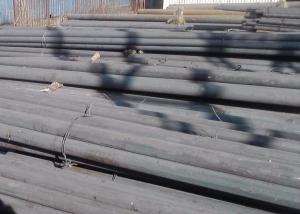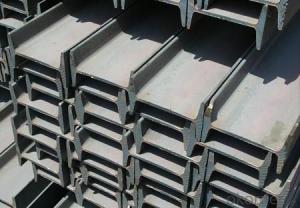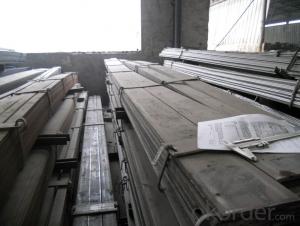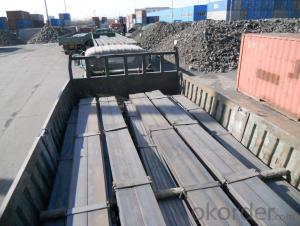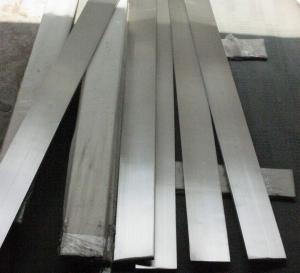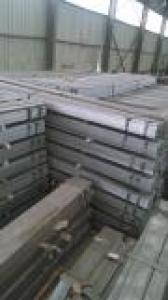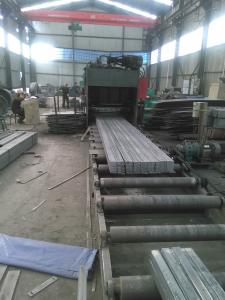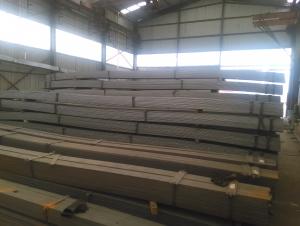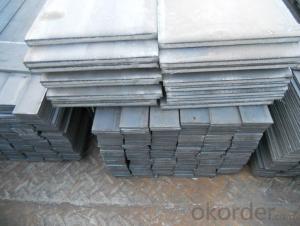Steel flat bars; flat steel high quality
- Loading Port:
- Shanghai
- Payment Terms:
- TT OR LC
- Min Order Qty:
- 25 m.t.
- Supply Capability:
- 10000 m.t./month
OKorder Service Pledge
OKorder Financial Service
You Might Also Like
Production Flow of STEEL FLAT SS400
The steel flat bar is made through three processes:
1.Feeding the material: Feeding the row material (the steel plate) to Slitting Line.
2.Slitting:The steel plate would be slitted into expected width by lengthways cutter.
3. Leveled and cutting: The plat bar would be ground into level by the grinder and then cut into required length
Tangshan flat bar processing plant
Our factory was founded in 2008, has been formed steel processing, trade, distribution, haihe river transportation and information service in the integration of modern company, the headquarters is located in the national steel rich district of tangshan city, hebei province, the first big province, covers an area of 20 mu, is apart from the beijing-shenyang high-speed 0.5 kilometers tangshan north exit, the geographical position is superior, the traffic is convenient.
The company owns the most advanced domestic shear steel equipment, plasma cutting equipment, can according to customer demand for steel plate kaiping, slitting, crosscutting, shear and winding and other personalized processing services, enable customers to save steel cut expenses and losses, greatly reduce the production cost, improve production efficiency. Its main products are steel billet, steel strip, flange plate and web plate, flat steel, open the tablet, etc.
Products applied to the export of flat steel, steel structure, steel plate, cars, ships, cement, steel girder plate socket, machinery manufacturing, bridge template, and other industries. Processing width: 10 mm - 1250 mm, the thickness of 1.5 mm - 16 mm, the length can be due to the needs of customers, annual processing capacity of 100000 tons. Product quality in line with the GB/T 709-2006carbon structure and hot rolled steel plate and strip of low alloy structure" of the relevant requirements.
In the increasingly market competition, the company in good faith integrity, mutual benefit and win-win principle sincerely look forward to cooperating with you!
Product description:
Processing capacity: 100000 tons/year; Slitting precision (width) : 0.5 mm or less
Raw material: Q235B, Q345B, Q235-1 b crosscutting precision (length) : 2 mm or less
Processing: the thickness of 2.0-16 mm; Shear length: 2000 mm above
Wide degree: 15-1250 - mm; Leveling precision: 1-2 MMM squared
- Q:Can steel flat bars be machined?
- Indeed, it is possible to machine steel flat bars. Machining entails utilizing machine tools to shape, cut, or drill a material. Steel, being a versatile substance, can be readily machined to fulfill specific requirements. To machine steel flat bars, one must employ a range of tools including lathes, mills, drills, and grinders to cut, shape, or generate holes in the metal. Nonetheless, it is crucial to acknowledge that the machinability of steel can differ based on its composition, hardness, and heat treatment. To attain the desired outcomes when machining steel flat bars, it is imperative to select the appropriate tools, cutting speeds, and feeds.
- Q:What are the different types of tests performed on steel flat bars?
- Steel flat bars undergo several common tests to ensure their quality and suitability for different uses. These tests evaluate the strength, durability, and other mechanical properties of the steel. Some of the tests conducted on steel flat bars include: 1. Tensile Test: This test determines the maximum amount of tensile stress the steel flat bar can withstand before it breaks. It provides information about the material's yield strength, ultimate tensile strength, and elongation. 2. Hardness Test: Assessing the hardness of a steel flat bar is crucial in determining its resistance to deformation, wear, and abrasion. Methods such as Rockwell, Brinell, and Vickers hardness tests are employed to measure the bar's hardness. 3. Impact Test: This test evaluates the steel flat bar's ability to absorb energy under high-stress conditions. By striking the material with a pendulum, the test measures the energy absorbed and the bar's resistance to cracking or breaking. 4. Bend Test: The bend test examines the steel flat bar's ductility and flexibility by bending it to a specific angle without fracturing. This test helps determine if the material is suitable for applications involving bending or forming processes. 5. Chemical Analysis: Chemical analysis is conducted to determine the composition of the steel flat bar, including the percentages of various elements like carbon, manganese, silicon, and others. This analysis ensures that the steel meets the required specifications and standards. 6. Ultrasonic Testing: Ultrasonic testing employs high-frequency sound waves to detect internal flaws or defects in the steel flat bar. It helps identify cracks, voids, or inclusions that might impact the overall integrity and strength of the material. 7. Dimensional Inspection: This test ensures that the steel flat bar meets the necessary dimensional tolerances and specifications. It involves measuring the bar's length, width, thickness, and other dimensions to ensure compliance with desired standards. 8. Microstructure Analysis: Microstructure analysis involves examining the metallurgical structure of the steel flat bar under a microscope. It aids in identifying the grain size, phase distribution, and any irregularities that may affect the material's mechanical properties. By conducting these tests, manufacturers, suppliers, and end-users can ensure that steel flat bars meet required quality standards and are suitable for their intended applications.
- Q:What is the typical hardness range for steel flat bars?
- The typical hardness range for steel flat bars is between 120 and 250 HB (Brinell hardness).
- Q:What is the difference between a steel flat bar and a steel angle bar?
- A steel flat bar and a steel angle bar are two different shapes of steel bars that serve distinct purposes in various applications. A steel flat bar, as the name suggests, is a rectangular-shaped bar with evenly distributed thickness throughout its length. It has a flat surface on the top and bottom, making it ideal for applications that require a level and smooth support or a structural component. Steel flat bars are commonly used in construction, manufacturing, and industrial settings where strength, stability, and load-bearing capacity are crucial. They can be easily welded, machined, or drilled, making them versatile for a wide range of applications. On the other hand, a steel angle bar, also known as an L-shaped bar, has two legs of equal or varying lengths that meet at a 90-degree angle. The legs can have the same or different thicknesses, depending on the desired strength and structural requirements. Steel angle bars are primarily used for structural support, reinforcement, and framing applications. They are commonly used to reinforce corners, joints, or edges of structures such as buildings, bridges, and machinery. The 90-degree angle provides additional strength and stability, making angle bars suitable for heavy-duty applications. In summary, the main difference between a steel flat bar and a steel angle bar lies in their shape and intended use. Steel flat bars have a flat surface throughout their length and are used for various applications that require a level and smooth support or structural component. Steel angle bars, on the other hand, have an L-shaped profile and are primarily used for structural support, reinforcement, and framing applications, especially where additional strength and stability are required.
- Q:How do steel flat bars perform in terms of fire resistance?
- Steel flat bars have excellent fire resistance properties. Due to their high melting point, they do not readily deform or lose their structural integrity when exposed to high temperatures. Steel has a melting point of around 1370 degrees Celsius (2500 degrees Fahrenheit), which is much higher than typical fire temperatures. This allows steel flat bars to maintain their strength and stability even in intense fire conditions. Moreover, steel does not contribute to the spread of fire as it is non-combustible. It does not release flammable gases or emit toxic fumes when exposed to fire, making it a safe choice for fire-resistant applications. Steel flat bars also have a slow rate of heat transfer, which means that they can effectively act as a barrier, slowing down the progression of heat from the fire to the surrounding areas. This can help contain the fire and prevent it from spreading to other parts of a structure. Furthermore, steel flat bars are often used in fire-rated assemblies and construction systems, such as fire doors, fire-resistant walls, and fireproofing systems. These applications are designed to meet specific fire resistance ratings and are tested to ensure they can withstand fire conditions for a certain amount of time. Overall, steel flat bars are highly reliable and perform well in terms of fire resistance. They offer structural stability, do not contribute to fire spread, and can effectively withstand high temperatures, making them an ideal choice for fire-resistant applications in various industries.
- Q:Are steel flat bars suitable for making material handling systems or equipment?
- Yes, steel flat bars are highly suitable for making material handling systems or equipment. Steel flat bars are known for their strength, durability, and versatility, making them ideal for applications that require heavy-duty support and load-bearing capabilities. They can be easily welded, cut, and formed into various shapes and sizes, allowing for customization to meet specific requirements. Material handling systems and equipment often need to handle significant loads and endure frequent use, and steel flat bars excel in these demanding conditions. They offer excellent resistance to impact, abrasion, and corrosion, ensuring long-lasting performance. Additionally, their rigid structure provides stability and reliability, reducing the risk of equipment failure or damage during material handling operations. Furthermore, steel flat bars are readily available in different grades and finishes, such as hot-rolled or cold-rolled, allowing for the selection of the most suitable material for the specific application. They can be used to construct various components of material handling systems, including frames, supports, guides, and brackets, providing a robust and dependable infrastructure. Overall, steel flat bars possess the necessary characteristics to effectively handle materials in diverse industrial settings. Their strength, durability, versatility, and availability make them an excellent choice for constructing material handling systems or equipment.
- Q:How do you prevent twisting of steel flat bars during welding?
- To prevent twisting of steel flat bars during welding, there are several measures you can take: 1. Proper preparation: Ensure that the flat bars are clean and free of any contaminants, such as oil, grease, or rust. Use a wire brush or grinder to remove any surface impurities. 2. Proper clamping: Securely clamp the flat bars in place before welding. Use sturdy clamps or magnetic welding fixtures to hold the bars firmly in position, preventing any movement or twisting during the welding process. 3. Tack welding: Prior to performing the full weld, use tack welds to temporarily hold the flat bars together. This will help maintain their alignment and prevent twisting while the final weld is being applied. 4. Weld sequence: Adopt a strategic weld sequence that minimizes heat distortion and potential twisting. Avoid welding a continuous bead along the entire length of the flat bars, as this can generate excessive heat and cause distortion. Instead, alternate between different sections or weld in short intervals, allowing each area to cool before proceeding. 5. Minimize heat input: Control the heat input during welding by using the appropriate welding technique and adjusting the welding parameters. High heat levels can cause the steel to expand and contract, leading to twisting. Employing techniques such as pulse welding or reducing the amperage can help control heat input and minimize the risk of twisting. 6. Preheating and post-weld heat treatment: For thicker or more susceptible steel flat bars, preheating the material before welding can help reduce the risk of twisting. Additionally, performing post-weld heat treatment can relieve residual stresses and prevent distortion. 7. Slow cooling: Allow the welded flat bars to cool slowly and naturally after welding. Rapid cooling, such as through water quenching, can induce additional stresses and contribute to twisting. Avoid abrupt temperature changes and provide adequate time for the welded bars to cool down gradually. By implementing these preventive measures, you can significantly reduce the risk of twisting in steel flat bars during welding, ensuring a successful and distortion-free weld.
- Q:What is the use of slitting flat steel?
- Flat cut flat steel, also called fine shearing flat steel strip, can be used to produce iron, tools and mechanical parts, and is used as frame structures and escalators for buildings.
- Q:What is flat steel, please?
- Steel strip steel rectangular and with pure edge of cold drawn steel, stainless steel flat steel. Stainless steel flat can be semi-finished steel. There are cold drawn polished stainless steel flat and hot-rolled acid white and sand blasting stainless steel flat. The raw material for producing stainless steel flat bar is stainless steel square billet, and the finished stainless steel flat bar is produced by hot rolling, normalizing or hot rolling, pickling (or sand blasting), cold drawing and polishing. The two sides are equal in width. The specifications are expressed in millimeters of edge width * * edge thickness. Such as 30 * 3, that is, width of 30 mm edge, 3 mm thick edge of stainless steel flat side.
- Q:How do steel flat bars perform in high-humidity environments?
- Steel flat bars generally perform well in high-humidity environments, but their performance can be affected by certain factors. Steel is known for its strength, durability, and corrosion resistance, which makes it suitable for various applications. However, in high-humidity environments, the presence of moisture can accelerate the corrosion process, potentially causing rust and deterioration of the steel. To mitigate the effects of high humidity, steel flat bars can be coated with protective finishes or treated with corrosion-resistant coatings such as galvanization. These coatings create a barrier between the steel and the surrounding environment, preventing or slowing down the corrosion process. However, it is important to note that the effectiveness of these coatings can vary depending on the quality of the coating and the severity of the humidity. In extremely humid or corrosive environments, it may be necessary to use stainless steel flat bars, which have a higher resistance to corrosion. Regular maintenance and inspection are also crucial in high-humidity environments to identify any signs of corrosion or damage early on. This can involve cleaning the steel regularly, removing any accumulated moisture or debris, and applying additional protective coatings if necessary. Overall, while steel flat bars can perform well in high-humidity environments, it is essential to consider the specific conditions and take appropriate measures to ensure their long-term durability and performance.
1. Manufacturer Overview |
|
|---|---|
| Location | |
| Year Established | |
| Annual Output Value | |
| Main Markets | |
| Company Certifications | |
2. Manufacturer Certificates |
|
|---|---|
| a) Certification Name | |
| Range | |
| Reference | |
| Validity Period | |
3. Manufacturer Capability |
|
|---|---|
| a)Trade Capacity | |
| Nearest Port | |
| Export Percentage | |
| No.of Employees in Trade Department | |
| Language Spoken: | |
| b)Factory Information | |
| Factory Size: | |
| No. of Production Lines | |
| Contract Manufacturing | |
| Product Price Range | |
Send your message to us
Steel flat bars; flat steel high quality
- Loading Port:
- Shanghai
- Payment Terms:
- TT OR LC
- Min Order Qty:
- 25 m.t.
- Supply Capability:
- 10000 m.t./month
OKorder Service Pledge
OKorder Financial Service
Similar products
New products
Hot products
Hot Searches
Related keywords
